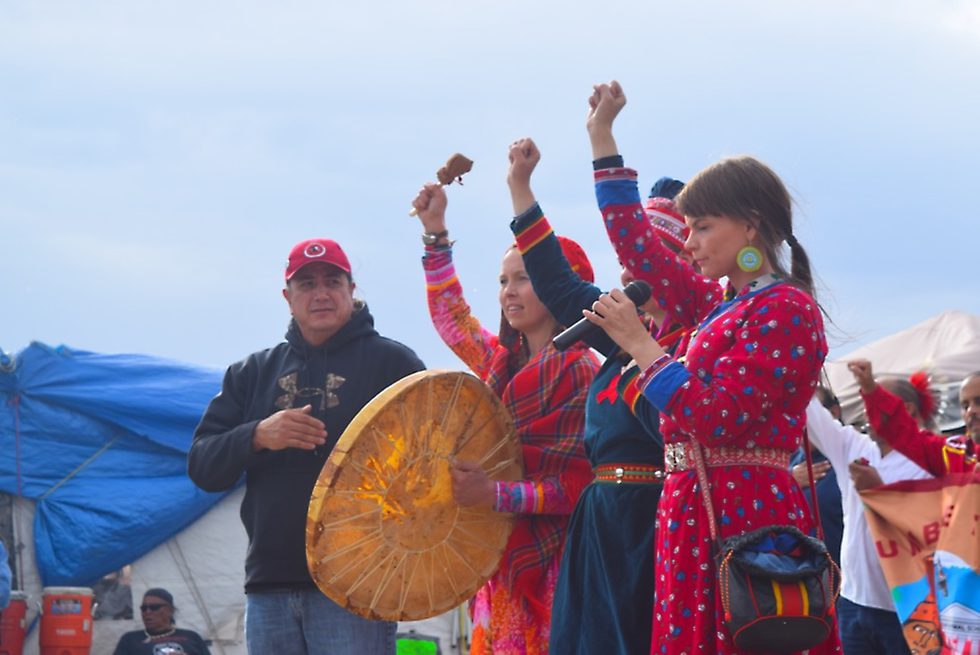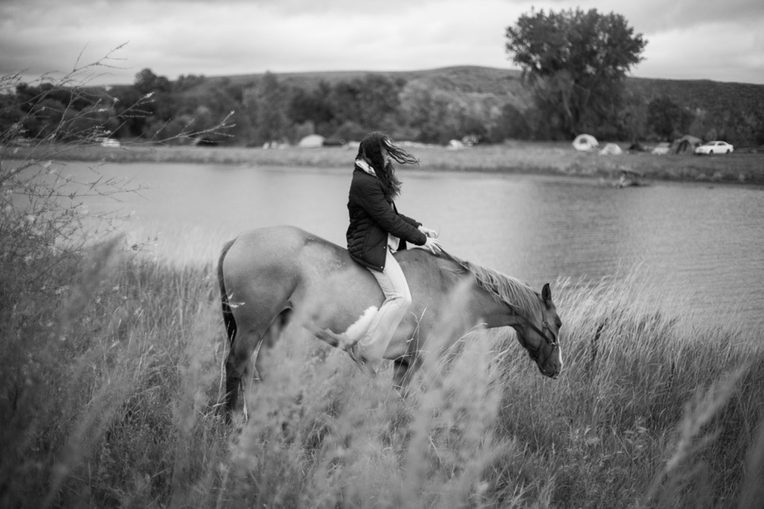#DeedsNotWords: A National Day of Water Protection Solidarity North of the Medicine Line
From the Series: Standing Rock, #NoDAPL, and Mni Wiconi
From the Series: Standing Rock, #NoDAPL, and Mni Wiconi

It started with a call from the east. Cheryl Maloney, a Mi’kmaqi land defender, was watching the expansion of the resistance camp at Standing Rock. She sent a message to the Defenders of the Land network, writing, “With the Dakota Access Pipeline protest in the middle of Turtle Island, Site C Dam in the West, and soon-to-be-active resistance to Alton Gas and turbines in the Bay of Fundy on the East Coast . . . we should do an international day of actions for water. It’s time to call the four directions.” The women’s committee of the Defenders of the Land network responded, and the day of actions was set for Canadian Thanksgiving Day.

On that day—the second Monday of October—First Nation and Inuit communities and their allies across the country took to the streets, ports, highways, and sites of critical infrastructure to link the struggle at Standing Rock with front-line struggles to protect water in Canada.
In Quebec, the Algonquins of Barriere Lake erected a traffic blockade on Highway 117, a few hours north of the nation’s capital, Ottawa. Stopping cars, they let travelers throughout the region know that the Indigenous people of Barriere Lake were fighting a proposed copper mine on their territory, which was approved by the province despite their explicit rejection of it. The mine is to be sited at the headwaters of the Ottawa River and threatens the entire watershed, including settler towns and cities downstream. A defense camp has since been established on the site—ten weeks ago at the time of this article’s publication—where multiple generations are determined to stay until the project is dead and gone.
In Vancouver, British Columbia, a foodless picnic was held for the Peace River region. Here, the provincial government has approved the Site C megadam on treaty-governed land, over the objections of First Nations whose territories will be devastated by flooding. The foodless picnic represented the loss of access to food, medicines, and sacred sites that will be destroyed. On the opposite coast, in Labrador, Innu and Inuit elders led a prayer ceremony at the site of Muskrat Falls, where a hydroelectric dam will impose irreversible and toxic impacts of methylmercury contamination on the Nunatsiavut, Nitassinan, and NunatuKavut communities living upstream from Lake Melville. Through blockades, hunger strikes, and by maintaining a constant, spirited presence at the site, the water protectors obtained concessions from the company to minimize the damage, but the dam has since flooded the region.
In Regina, Saskatchewan, local solidarity activists and Cree water protectors shut down the Husky Gas station to draw attention to the devastating oil spill into the North Saskatchewan River in July 2016. People also demanded the government meaningfully engage with Indigenous peoples on proposed mining and pipeline projects—a promise that was made by the Liberal government one year earlier when it swept to power, but not kept. In Fort Qu’Appelle, Saskatchewan, the local Cree community carried signs to show their solidarity with the Standing Rock Sioux. They linked their struggles to protect the water by identifying and protesting the ecological damage incurred in the Qu’Appelle Valley Lakes due to contaminants dumped in the waterway.
In the territory covered by Peace and Friendship Treaties, Mi’kmaq water protectors held demonstrations at the site of a proposed natural gas storage site on the Shubenacadie River. Alton Gas is attempting to hollow out salt caverns to store the gas and release salt brine into the river. This project directly threatens the river ecosystem where striped bass eggs and larvae spawn in the river and dozens of other species of animal and plant life thrive. A Thanksgiving feast was served after the demonstration at Millbrook First Nation, attended by the respected Anishinaabe elder and water protector Josephine Mandamin, who traveled from Thunder Bay to join the Mi’kmaq communities on the frontlines. Similar events sprang up across Nova Scotia.
In Toronto, Ontario, a round dance attended by hundreds of Indigenous peoples of many nations and their allies was held in the busiest intersection of the downtown, forcing traffic to a halt. Crystal Sinclair, a Cree organizer who visited Standing Rock with a local Idle No More crew, spoke at the gathering honoring women for their traditional role as water protectors. All over Ontario, solidarity actions sprang up. In Kitchener-Waterloo, at a municipal Thanksgiving Day parade, a banner was dropped that read “Water is Life.” In Thunder Bay, a feast was held by Fossil Free Lakehead to raise awareness about the threat of extractive projects like TransCanada’s Energy East Pipeline; in Windsor, Ontario, people took to the streets to demand clean drinking water.
The problem of water in Canada is not only rooted in the need to protect it from toxic contamination and destruction as a result of development, but also in the fight for survival against a racial hierarchy that determines who has access to clean water and who does not. This past summer, there were 158 drinking water advisories in effect in over a hundred First Nations communities across Canada, and many of them have been in place for decades. Systemic underfunding of basic infrastructure on reserves has made running water—an essential service in urban centers—a luxury for Indigenous peoples.
While so many struggles against colonization are focused on building movements based on Indigenous belonging to the land, the NoDAPL battle has brought the crucial role of water as a site of Indigenous self-determination to the forefront.
Land is central because the extraction of valuable resources from the earth and the circulation of commodities across vast territories have instigated colonial wars for ownership and settlement of Indigenous homelands. But the capillaries of capital have also historically extended along watery highways, as settlers made their way into the dense new terrains of the West by following Indigenous peoples along navigable river, lake, and ocean routes. For settlers to poison, dam, and waste the water is to choke closed the veins to this world that Indigenous peoples opened to newcomers with the expectation of mutual gain and respect. When Indigenous peoples protect the waters, in addition to all the other work they are doing, we should read this as a signal of the failure of settlers to fulfill our right to be here.
The hashtag #DeedsNotWords attached to the day of action in Canada was born of the growing awareness that the new federal government in Canada, led by Prime Minister Justin Trudeau, uses the language of “recognition” and “reconciliation” falsely. At the end of September, the federal government approved the dangerous and environmentally destructive Lelu Island liquid natural gas plant, explicitly against the demands of local First Nations. The multibillion-dollar export terminal on the northern coast of British Columbia was approved to export natural gas against the wishes of the Gitwilgyoots tribe of the Lax Kw’alaams First Nation, the Gitanyow hereditary chiefs and the SkeenaWild Conservation Trust. The Trudeau government campaigned on a platform to implement the UN Declaration on the Rights of Indigenous Peoples, which adopts the standard of free, prior, and informed consent of Indigenous peoples on their lands. The prime minister has since informed chiefs from across Canada that adopting the Declaration is unworkable. And now they have backtracked on their obligations under the Paris climate accords, too.
From Neskantaga First Nation trying to stop the mining company Noront from drilling on its land, to Indigenous peoples and allies fighting toxic, reckless pipeline and oil development in places like Aamjiwnaang, Kanehsatake, Unist’ot’en, Tsleil-Waututh, and Secwepemc territory, these struggles to defend the land and water can form powerful networks of resistance and solidarity. As Standing Rock has shown, we answered the call and continue to answer the call north of the border between the United States and Canada, the border Indigenous people once called the Medicine Line.
Shiri Pasternak is an organizer and educator. She works as an ally in the Defenders of the Land network, and is one of the founders of Barriere Lake Solidarity. She is Assistant Professor at the School for the Study of Canada at Trent University. Her first book, Grounded Authority: The Algonquins of Barriere Lake Against the State, is forthcoming in 2017 with University of Minnesota Press.